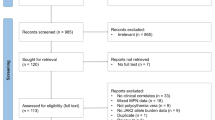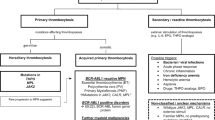Abstract
Essential thrombocythemia (ET) is a myeloproliferative neoplasm characterized by an increased risk of thrombotic and hemorrhagic events, that represent the leading causes of mortality and morbidity. Currently, while thrombotic risk is assessed through the IPSET-t and r-IPSET scores, there is no specific prognostic tool used to predict hemorrhagic risk in ET. The aim of the study was to define incidence and risk factors connected to hemorrhagic events by retrospectively analyzing 308 ET patients diagnosed between 1996 and 2022 at the Division of Hematology of Udine and treated according to the current international guidelines. According to molecular status, 193 patients (62.7%) were JAK2 mutated, 66 (21.4%) had a CALR mutation, 14 (4.5%) had a MPL mutation, 21 patients (6.8%) were “triple negative,” and 14 patients (4.5%) were not evaluable. According to IPSET-t score, 49.7% patients were at high, 24.3% at intermediate, and 26.0% at low-risk, respectively. Twelve (3.9%) patients experienced bleeding at ET diagnosis, while 24 (7.8%) had at least one hemorrhagic event during follow-up at a median time of 103 months (range: 1–309). Forty hemorrhagic events were totally recorded and defined as minor in 22 cases, moderate in 11 cases, and severe in 7 cases. Cumulative incidence (CI) of hemorrhage at 10 and 20 years was 6.0% and 12.0%, respectively. A statistically significant correlation between hemorrhagic risk and IPSET-t score emerged: 10 years hemorrhage CI was 3.2% for low-risk, 2.9% for intermediate-risk, and 9.8% for high-risk patients, respectively (p=0.002). We found no correlation between hemorrhagic risk and gender or mutational status. Results of our study highlight the validity of IPSET-t score in predicting individual hemorrhagic risk among ET patients, suggesting a possible role of IPSET-t scoring system as a global evaluator for vascular events in ET patients.


Similar content being viewed by others
Change history
29 December 2023
A Correction to this paper has been published: https://doi.org/10.1007/s00277-023-05608-5
References
Tefferi A, Barbui T (2020) Polycythemia vera and essential thrombocythemia: 2021 update on diagnosis, risk-stratification and management. Am J Hematol 95(12):1599–1613
Guglielmelli P, Vannucchi AM (2020) Current management strategies for polycythemia vera and essential thrombocythemia. Blood Rev 42:100714
Rungjirajittranon T et al (2019) A systematic review and meta-analysis of the prevalence of thrombosis and bleeding at diagnosis of Philadelphia-negative myeloproliferative neoplasms. BMC Cancer 19(1):184
Nicol C et al (2021) Hemorrhage in essential thrombocythemia or polycythemia vera: epidemiology, location, risk factors, and lessons learned from the literature. Thromb Haemost 121(5):553–564
Appelmann I et al (2016) Diagnosis, prevention, and management of bleeding episodes in Philadelphia-negative myeloproliferative neoplasms: recommendations by the Hemostasis Working Party of the German Society of Hematology and Medical Oncology (DGHO) and the Society of Thrombosis. Ann Hematol 95(5):707–718
Barbui T et al (2018) Philadelphia chromosome-negative classical myeloproliferative neoplasms: revised management recommendations from European LeukemiaNet. Leukemia 32(5):1057–1069
Barbui T et al (2012) Development and validation of an International Prognostic Score of thrombosis in World Health Organization-essential thrombocythemia (IPSET-thrombosis). Blood 120(26):5128–5133
Stein BL, Martin K (2019) From Budd-Chiari syndrome to acquired von Willebrand syndrome: thrombosis and bleeding complications in the myeloproliferative neoplasms. Blood 134(22):1902–1911
Carobbio A et al (2011) Risk factors for arterial and venous thrombosis in WHO-defined essential thrombocythemia: an international study of 891 patients. Blood 117(22):5857–5859
Haider M et al (2016) Validation of the revised international prognostic score of thrombosis for essential thrombocythemia (IPSET-thrombosis) in 585 Mayo clinic patients. Am J Hematol 91(4):390–394
Finazzi G et al (2012) Incidence and risk factors for bleeding in 1104 patients with essential thrombocythemia or prefibrotic myelofibrosis diagnosed according to the 2008 WHO criteria. Leukemia 26(4):716–719
Cattaneo M (2023) Aspirin in essential thrombocythemia. For whom? What formulation? What regimen? Haematologica 108(6):1487–1499
Alvarez-Larrán A et al (2016) Antiplatelet therapy versus observation in low-risk essential thrombocythemia with a CALR mutation. Haematologica 101(8):926–931
Stuckey R et al (2023) Prediction of major bleeding events in 1381 patients with essential thrombocythemia. Int J Hematol 118(5):589–595
Tefferi A, Barbui T (2015) New and treatment-relevant risk stratification for thrombosis in essential thrombocythemia and polycythemia vera. Am J Hematol 90(8):683–685
Data availability
Available upon reasonable request.
Author information
Authors and Affiliations
Contributions
LT and MT conceived the study, analyzed the data, and wrote the paper; GM, MEZ, DL, CF, ES, GB, CG, and MF collected data; DD and RF critically revised the paper.
Corresponding author
Ethics declarations
Ethics approval
Obtained by the IRB of the Department of Medicine, University of Udine (PROT IRB 50/2023).
Competing interests
The authors declare no competing interests.
Additional information
Publisher’s note
Springer Nature remains neutral with regard to jurisdictional claims in published maps and institutional affiliations.
The original version of this article was revised: This article was originally published without a missing author name Matteo Liberi1.
Rights and permissions
Springer Nature or its licensor (e.g. a society or other partner) holds exclusive rights to this article under a publishing agreement with the author(s) or other rightsholder(s); author self-archiving of the accepted manuscript version of this article is solely governed by the terms of such publishing agreement and applicable law.
About this article
Cite this article
Tosoni, L., Liberi, M., Morelli, G. et al. Correlation between IPSET-t risk at diagnosis and subsequent hemorrhage in patients with essential thrombocythemia; a single institution experience. Ann Hematol 103, 443–448 (2024). https://doi.org/10.1007/s00277-023-05578-8
Received:
Accepted:
Published:
Issue Date:
DOI: https://doi.org/10.1007/s00277-023-05578-8




